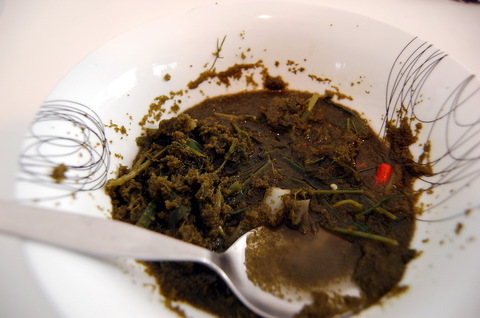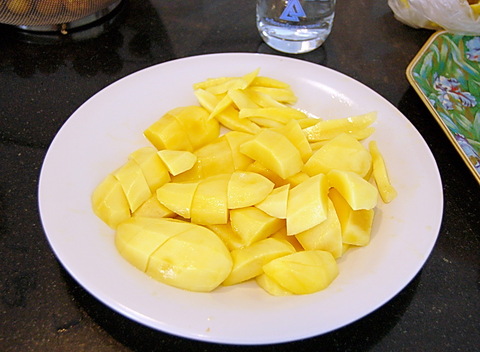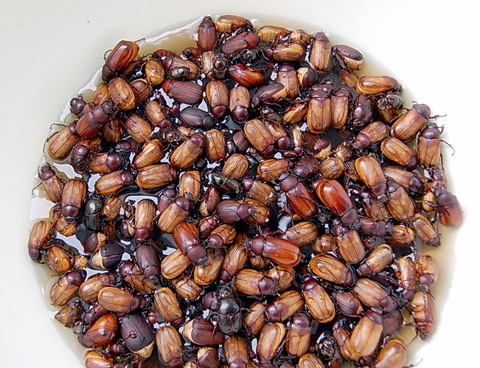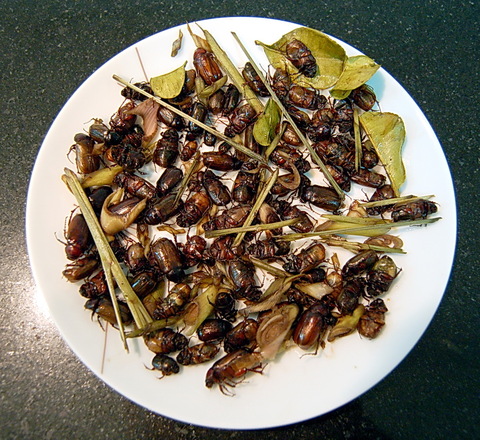Is it me or do they sound a bit like the D?
Category: Food
Pond Scum Soup
On Sunday we went to an outdoor market in a park downtown where many fresh produce vendors gather. It’s an excellent place to find strange new (to me anyway) fruits and veggies, and sometimes even plants for our garden. This day proved to be no exception and we found a lady selling what looked like Japanese aojiru powder (green juice powder made from barley and other healthy crap) from a bucket. Upon closer inspection the granules were too large to be aojiru and were also quite damp. The old lady didn’t really explain what it was that well to Nam, so we had our nanny go ask. Nanny already knew what it was and said she could prepare a soup with it, so I of course bought some, about a pound, for 15 Baht (45 cents).
It turned out to be some kind of vegetation that grows on the surface of a pond, or as I like to call it, pond scum.
The soup she made was quite good; it smelled pleasant and tasted hearty with a hint of lemongrass, and the texture of the scum was like miniature flying fish roe, or soft grains of sand. Nanny said it would have been better if she’d had pork belly to add to it, but really, what food couldn’t benefit from some pork belly?
Cake Wreck
This is perhaps my favorite entry on the whole Cake Wrecks blog:

It’s Mango Season
Around these parts, mango season comes at the hottest time of the year. This year, luckily, we have been blessed with rain almost every week, which brings down the temperature and gives everybody a nice respite from the dry heat. The first five months or so when I first came, it didn’t really rain at all, so it’s been nice having a cooler hot season last year and an even cooler one this year.
Back to mangoes, though – everybody seems to have mango trees growing in their yard and a single mature tree can produce perhaps hundreds of fruit every season. So visitors over the past few weeks have kept our fruit baskets overflowing with all different varieties and flavors of mangoes. Combined with the fruit on one of our banana trees ripening a couple weeks ago, Max and family have been enjoying a truly bountiful harvest.
/////////////////////////////

/////////////////////////////
This afternoon while Max slept, it rained again and I sat on the porch with a pocketknife, a plastic bucket, and a few dozen mangoes. I started peeling them one by one and sucking all of the flesh off the pits. Before long, the bucket was filled with pits and skins and sweet mango juice was dribbling down my arms. About the closest sensation I can think of back home is eating fresh peaches: Sweet, sticky fun. The only difference is that mangoes grow all over the place here – it’s one of the most common fruits grown in people’s yards. Thank god for that.
After I could eat no more, I planted the pits outside our fence to begin a new cycle.
No escape from the barbie
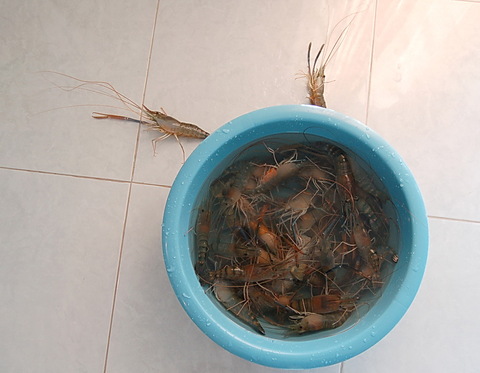
Monster freshwater shrimp trying to get away on Max’s birthday a couple weeks ago.
They were delicious, especially the ones rich with roe. Nam made a traditional nam chim dip with lime, chili, vinegar, fish sauce, and sugar. I secretly added pork bouillon for the hell of it, and it turned out very well.
near wild heaven
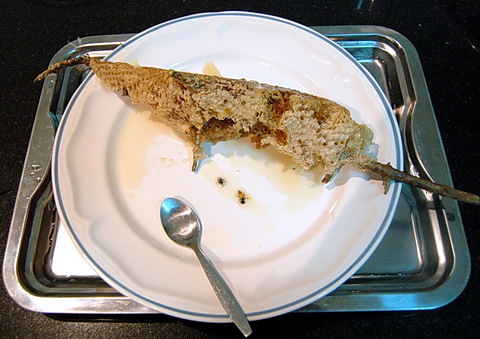
An old woman came by my table at an outdoor restaurant, selling this (plus another similarly-sized chunk) out of a basket. It was the last of her merchandise so she let me have it for 50 Baht ($1.50 US); about 30% off the going rate.
There is nothing more delicious than wild honey, even just a very small amount (It’s the reason Pooh bear is such a fat ass, after all.).
good or bad?
Philippine fishermen net and eat rare megamouth shark

My initial reaction when I read the headline was that of disgust, but I guess the main question is whether the animal would have gone to waste if they hadn’t eaten it… Would the WWF have preserved it for study? If so, why didn’t they offer to buy it? Would the fisherman have gone hungry if they hadn’t eaten it?
Red-bellied Pacu in Thailand
Our nanny’s husband has been bringing over various culinary delights (of mostly the jungle food variety) recently since he knows I get a kick out of it and so far, have not refused to try anything. In fact, he’s brought over so much that I’ve not had the time to blog about all of it yet (the photos are ready though, so everything will be covered eventually). A few days ago, he brought over a real treat.
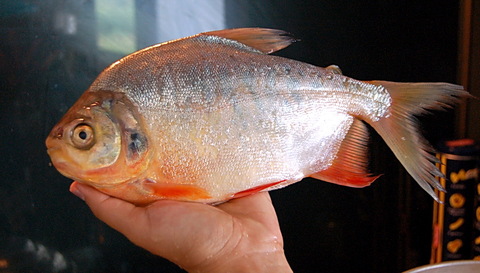
I knew what it was right away because I’ve seen so many nature programs about Amazonian fish: That’s a small pacu. Some googling showed that it’s probably called a red-bellied pacu. The huge pacu you see on fishing shows are usually black pacu. Pacu of any kind are not native to Thailand but seem to thrive here in the tropical conditions, and since pacu can eat basically anything with their gnarly goatlike teeth, food isn’t a problem either. I’m not totally sure if Yao (the nanny’s husband) caught this in a river or a fishing park, but it could be either.
The photo above was taken right before Mr. Pacu got placed in the steam pot. We steam a lot of the fish we eat these days with little or no seasoning so Max can eat with us. Many fish in Thailand taste just fine this way, as log as you season or use a dip afterward. Pacu, however, turns out to be quite devoid of any real taste – the texture is nice and firm, but the flavor is lacking (which is not the case with, say, tilapia or striped goby, or even most river catfish around here). Pacu would be a good candidate for garlic/butter/white wine pan frying I suspect, where a bland fish can really shine.
Sure is a pretty fish, though.
Nankin no Hana
The Japanese pumpkins I planted inside and outside our fence have really taken to the climate here and were in full bloom last week. That’s when our nanny told us you can eat the flowers and stems – I never knew that!
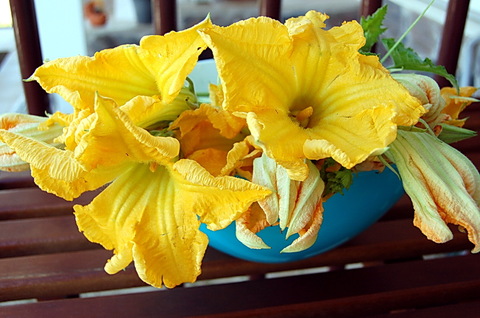
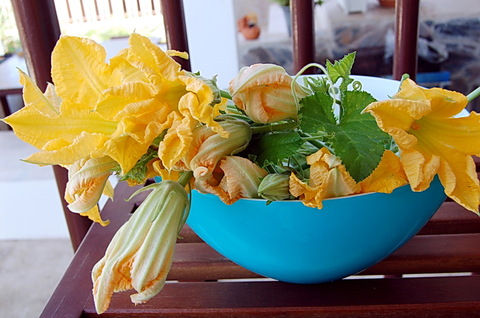
Before eating, the small hairs on the stems (that cause contact allergies on many people) have to be scraped off. After that was done, we lightly steamed them and ate with no seasoning. I won’t go so far as to say they were delicious, but they were pleasant to eat on another level, like having the very essence of nature in your mouth. I can’t imagine eating them any other way, really.

